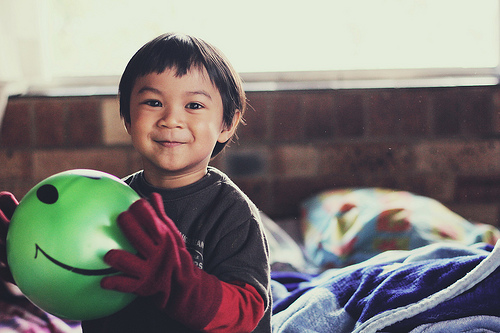Teaching Your Child Ball Skills—Part 1: Catching
 Did you know that you can work with a newborn on ball skills? Ok, she's not going to be playing catch with you right away, but playing ball involves a complex group of skills, some of which you can be helping your child develop from infancy. Here is a sequence of activities that you can work on with your child as she grows to help her develop coordination, strength, and motor skills that will benefit her all her life.
Did you know that you can work with a newborn on ball skills? Ok, she's not going to be playing catch with you right away, but playing ball involves a complex group of skills, some of which you can be helping your child develop from infancy. Here is a sequence of activities that you can work on with your child as she grows to help her develop coordination, strength, and motor skills that will benefit her all her life.
Two notes: as with all activities, stop before your child gets bored or tired. Very short spurts of these activities are fine—in fact, great! Second, if your child is not a baby any more, it's not too late! You can still play these games together and use many of the same activities to teach a preschooler or elementary schooler to catch.
1. Tracking with the eyes. You know the saying, "Keep your eye on the ball"? Being able to track a moving object with the eyes is a skill that infants don't yet have, but that can be worked on and developed. Begin by catching his eye, then slowly move your face side to side. As you notice him being able to follow you with his eyes, you can begin to hang interesting toys on a string or shoelace and move it slowly side to side and then up and down. This not only prepares baby for ball-play, but lays a foundation for future reading and helps develop attention span.
2. Clapping. The movement baby uses for clapping is the same movement she will initially use to catch. Play games like "Patty Cake" and cheer for your baby whenever she does something exciting. She will soon start mimicking you and gain the coordination to clap.
3. Clap a scarf. Catching needs to be learned first on a slow-moving object. A great first choice is a scarf or a piece of tulle fabric. Your baby needs to be able to sit up to do this, and you should support him with pillows so he doesn't topple over when he looks up. Get his attention with the tulle scarf, then raise it up and let him follow it with his gaze. Then say, "Clap!" While he is clapping, bring the scarf down until it's between his hands. Say, "Look! You caught it!" When he gets the hang of this, you can begin to drop the scarf toward his clapping hands. He will begin to "clap" the scarf, catching it.
4. Catch a soft, squishy ball. Balls that babies can actually grab with a fist work well. You can under-inflate a beach ball or use a squishy, foamy ball. It should be large enough that baby can catch it without having to do too much work with her arms. Start by telling her to hold out her arms (show her how), and drop the ball into her arms. When she is getting the hang of this, you can "throw" it to her (while really keeping hold of it until it's almost in her arms.) Then begin to gently throw it from a short distance away, moving back gradually. Make sure to celebrate each catch!
5. Slowly graduate to heavier and smaller balls. As your child masters catching a big, soft ball, you can try balls with slightly more heft to them (I'm not talking medicine balls here—more like Nerf balls and kickballs, and then wiffleballs and tennis balls. Don't use anything hard or heavy like a baseball until your child is really good at catching.
Celebrate all the progress you two have made!
Photo Credit: SakinaKina cc
Related Posts
By accepting you will be accessing a service provided by a third-party external to https://growthandgiggles.com/

